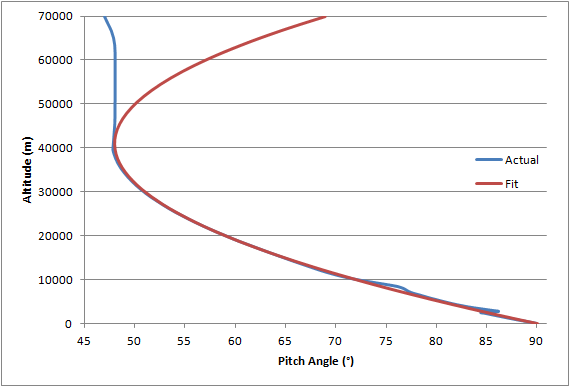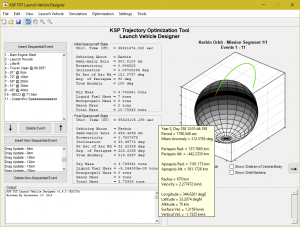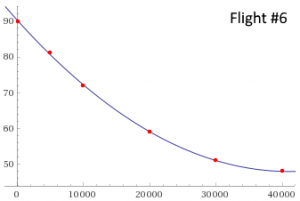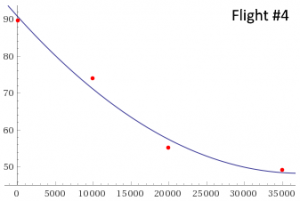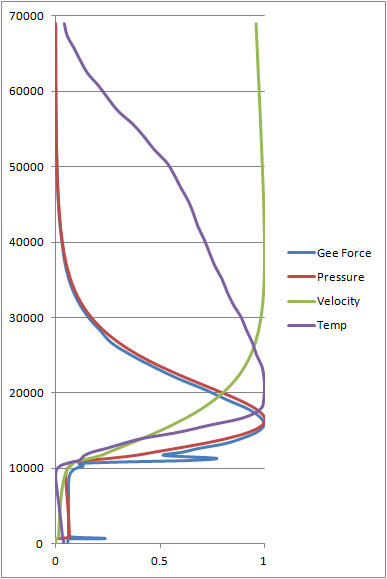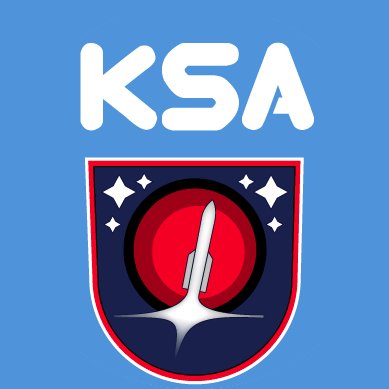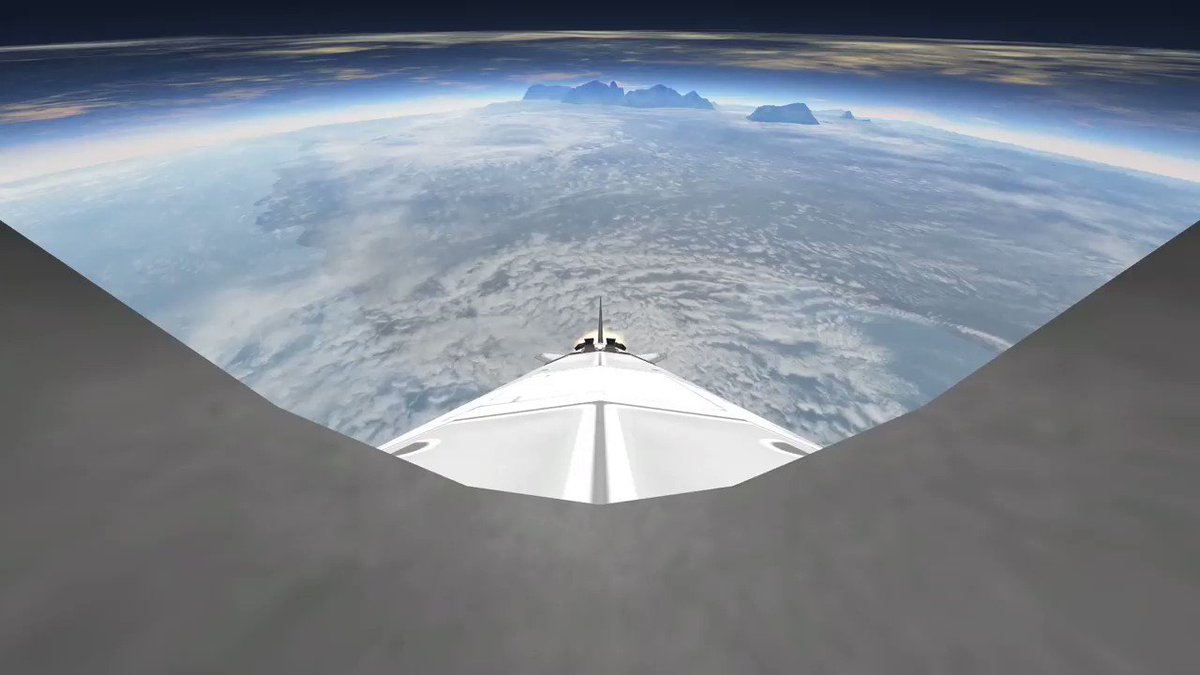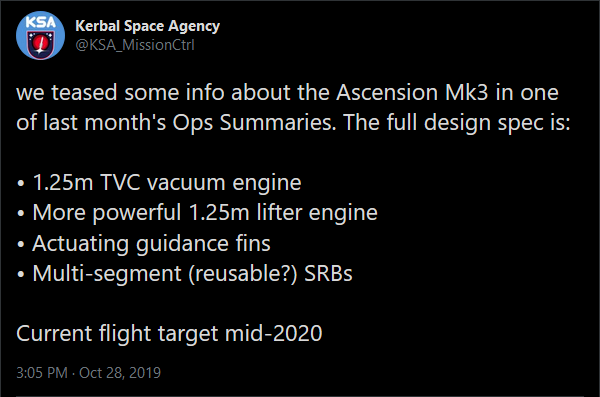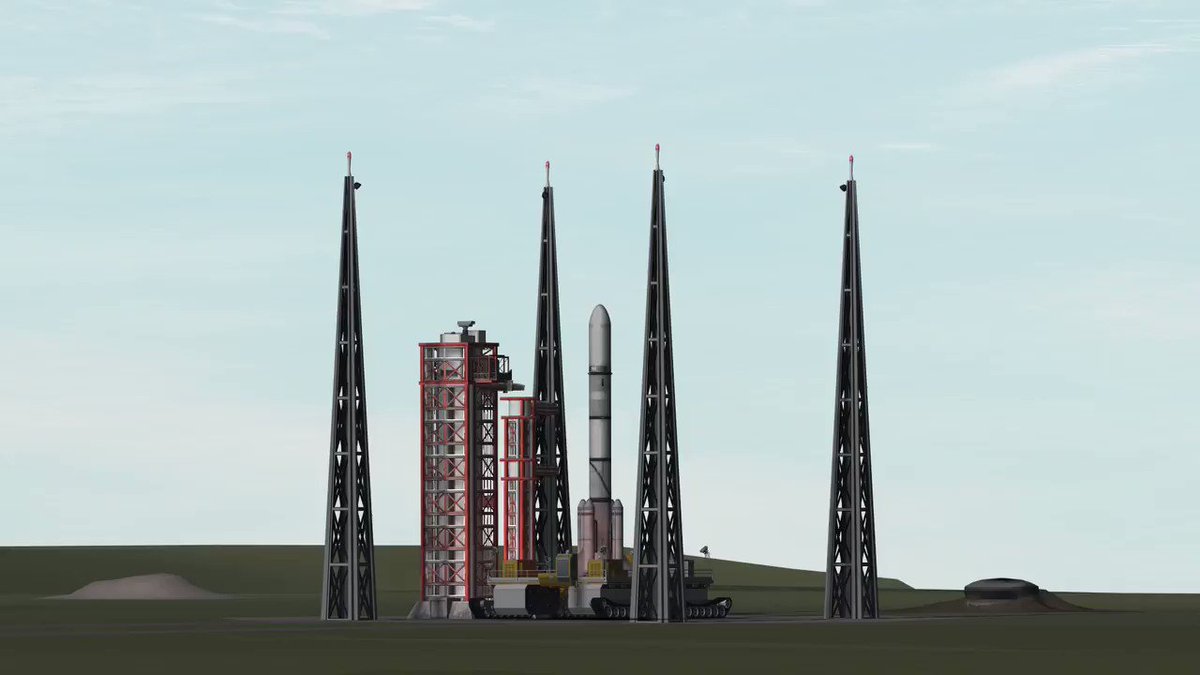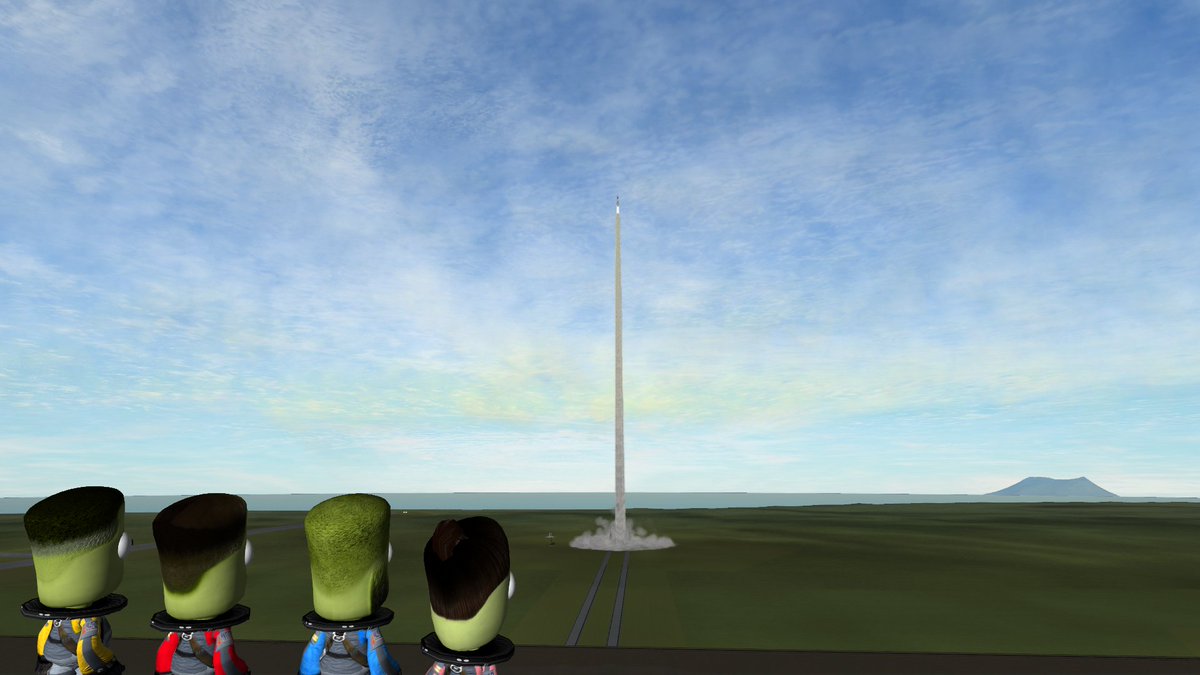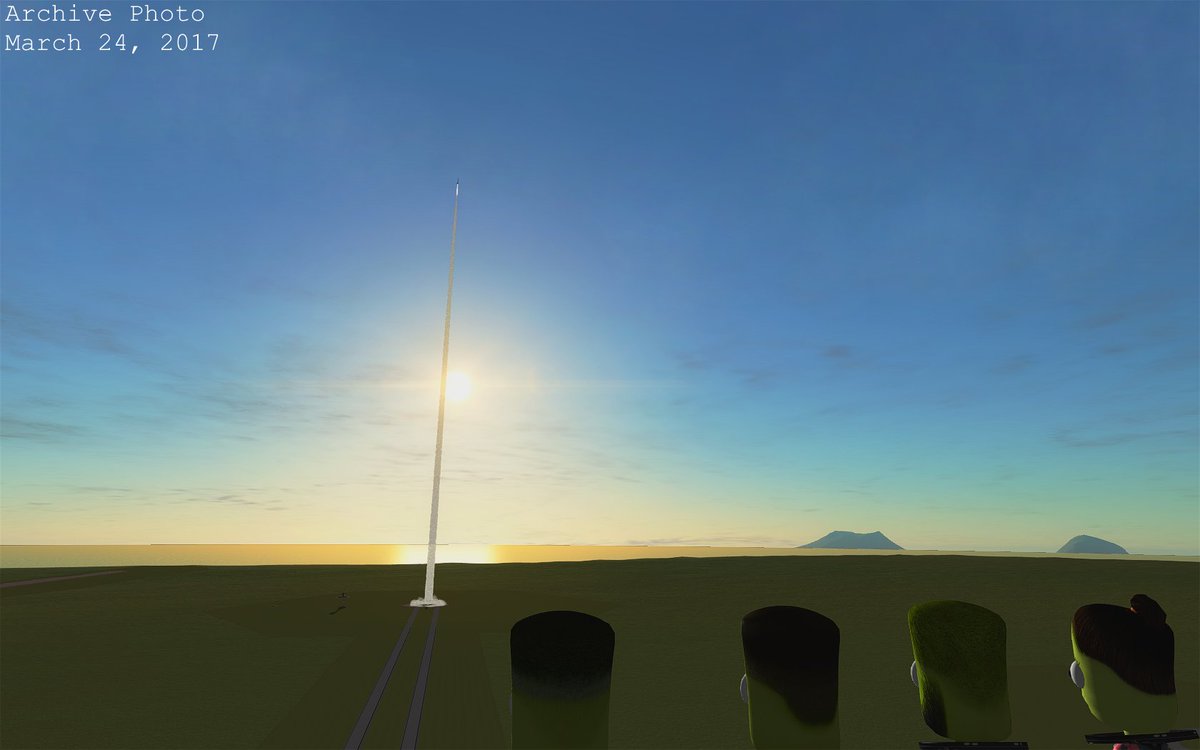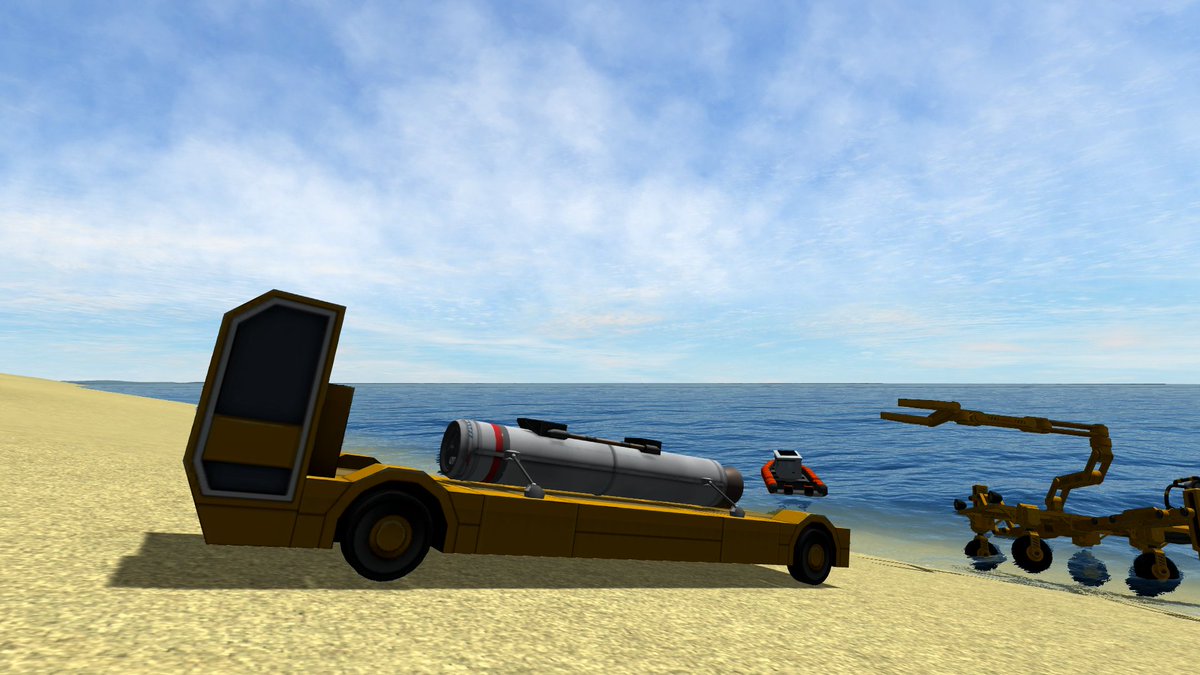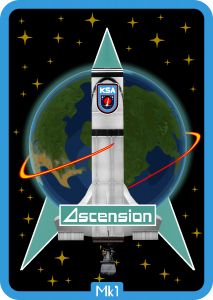 This flight was the second uncrewed test of the Mk1 space capsule with hopes for a possible kerbed mission to follow along a similar trajectory. After the LES mishap on the first test flight, this test flight was designed along a similar path to gather the original data we wanted without the premature LES activation affecting the parabolic arc. Additional considerations were made based on the last mission such as erecting a new communications relay tower to provide the greatest radio coverage – allowing the returning capsule to remain in contact with KSC all the way through to full chute deployment. This necessitated a different launch azimuth for a lower latitude landing target to remain in as direct a line east as possible with the radio tower.
This flight was the second uncrewed test of the Mk1 space capsule with hopes for a possible kerbed mission to follow along a similar trajectory. After the LES mishap on the first test flight, this test flight was designed along a similar path to gather the original data we wanted without the premature LES activation affecting the parabolic arc. Additional considerations were made based on the last mission such as erecting a new communications relay tower to provide the greatest radio coverage – allowing the returning capsule to remain in contact with KSC all the way through to full chute deployment. This necessitated a different launch azimuth for a lower latitude landing target to remain in as direct a line east as possible with the radio tower.
The Flight
Launch was later in the day cycle than originally planned thanks to some poorly-connected cables in the capsule that shook loose when the service towers swung away at the start of the terminal countdown. They had been plugged in just enough to provide data, although during preflight controllers had noticed some intermittent dropouts. After holding the count and offloading the pressurized gas, the pad crew used an emergency procedure set in place for removing a disabled astronaut to access the capsule. The upper service arm was re-attached and crew clambered out to the rocket, hooked on to the Launch Escape Tower and swung around to the hatch. After fixing the cable and replacing the battery, which had powered the rocket too long during the initial troubleshoot after countdown hold to last the flight through space, the capsule was buttoned up and the countdown reset for launch.
Lift off occurred on time for the new L-0 of 18:30 UTC, sending the rocket off the pad with 1.2 TWR launch power. Once clear of the tower 3 seconds later throttle was increased up to full thrust and for the first time the rocket made a small roll to change its heading off the 45° launch orientation to point 53° as it pitched over to head downrange.
Ascent was nominal up to L+28s when the rocket showed a large fluctuation in pitch, something we’ve seen on past flights and as of yet have no explanation for. As with past flights though the rocket remained stable and continued to pitch over at a nominal rate, following the guidance computer to work through the predetermined pitch profile. Passing through Mach 1 the rocket picked up some roll shake as it continued into supersonic speeds and through a MaxQ of 32.924kPa but again the aerodynamic controls were able to maintain heading and pitch-over as programmed.
At L+1m15s the rocket was approaching Mach 3 and climbing through 26km at a velocity of just under 1km/s. This was fast enough to heat up the surrounding air and create a plasma shockwave that heated up the exterior of the capsule to 534.9K (503.15°F/261.75°C) – however the interior only eventually got as hot as 304K (87.53°F/30.85°C). Telemetry beamed back towards the ground was not affected by the ionized air in front of the rocket.
By the time the heating subsided at L+1m35s the rocket was already at its maximum planned pitch of 48° and holding while it continued to push towards space, passing through 45km. A short time later at L+1m51s the engine ran out of fuel and cut off just 3km short of space. The rocket coasted out of the atmosphere at over 2km/s and when it reached 100km at L+2m11s the capsule was released from the lifter. The RCS system activated and thrusted forwards for 10 seconds to push the capsule well clear of the fuel tank so it had room to maneuver and would also not crash back into it later on during re-entry.
Controllers immediately got to work sending up control commands to orient the capsule along the major orbital vectors of prograde, retrograde, radial-in, radial-out, normal and anti-normal. Unlike the previous mission the LES remained attached and this did affect the rate at which the capsule was able to maneuver with its cold gas thrusters. The guidance computer this time was no longer fighting against itself however which allowed the capsule to successfully orient along all major vectors without issue, taking an average of 1m16s to move between each.
By the time the capsule passed through 485.461km apokee (75km lower than planned) at L+11m27s the operations crew on the ground were able to take manual control to steer the capsule around to various vectors without computer guidance. They first rolled the capsule “up” for better orientation and then carefully thrusted with yaw and pitch to the desired vector. No control issues were noted and plenty of cold gas remained by the time they had to re-enable computer control to point retrograde and present the heat shield to the fast-approaching atmosphere.
The capsule began re-entry at L+21m02s and upon reaching the top of the atmosphere the RCS was disabled to allow for a ballistic descent. It plummeted down at speeds up to 2.3km/s, reaching a peak deceleration force of 16.763Gs as it was slowed by thicker air of the lower atmosphere below 18km. The heat shield once again did its job, reaching a peak temperature of 1879K (2,922.53°F/1,605.85°C) while the capsule interior reached a peak of 307.2K (93.29°F/34.05°C) – a bit outside of what would be considered comfortable but certainly not deadly.
Once through the toughest re-entry regime and reaching initial chute deployment speed the Launch Escape System fired its four push motors. Acting as retro-thrusters they slowed the capsule from 489.297m/s to 230.137m/s over a span of 2.52 seconds with a peak force of 13Gs. This was a test of the LES being used for more than just the first phase of the mission and the LES tower was immediately discarded afterwards so the chutes could pop out reefed and further slow the capsule. Once it fell below 1km the chutes fully opened to arrest the descent rate to ~5m/s. Seconds before splashdown the heat shield was dropped to allow the capsule floats to deploy.
The capsule was recovered 702km downrange and only came down into the atmosphere ~20km from where it was planned.
Flight Telemetry Data I AFCS Repository
Flight Analysis
Pitch “Bump”
Turns out we were wrong about why the rocket was making a relatively large pitching motion early in the ascent. Our theory about it being linked to the radar altitude mentioned in the report of the 4th flight was not correct, since we fixed the guidance code as planned and the bump still occurred. However thanks to this mission occurring along a different heading than the one at launch we were able to learn something new when taking a closer look at the telemetry for how the rocket was orienting itself after clearing the tower. It took almost a minute for the guidance to find the proper heading, as seen in this normalized plot:
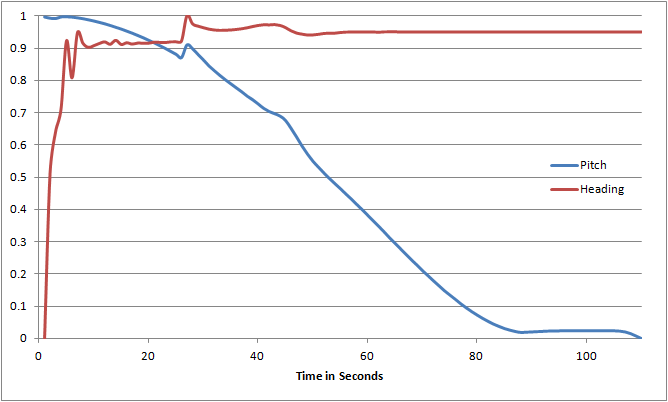 Where the red line flattens out is when the rocket is finally pointing 53°. At the start of the launch the heading was way off, and in the places where it made large corrections you see a similar effect on the pitch since the roll and pitch use the same control surfaces. The larger heading adjustments very early on did not affect the pitch as much since the rocket was still standing up rather straight. Now lets take a look at how the rocket’s pitch profile looked compared to what it was supposed to look like given the quadratic fit function that was used:
Where the red line flattens out is when the rocket is finally pointing 53°. At the start of the launch the heading was way off, and in the places where it made large corrections you see a similar effect on the pitch since the roll and pitch use the same control surfaces. The larger heading adjustments very early on did not affect the pitch as much since the rocket was still standing up rather straight. Now lets take a look at how the rocket’s pitch profile looked compared to what it was supposed to look like given the quadratic fit function that was used:
Looking at the full-sized plot you’ll see the actual pitch does not merge with the fit plot until around 16km, which is the same point at which the rocket’s heading stabilized at 53° and the rocket could devote all attention to pitching properly. Passing 30km the plots again begin to deviate but this is expected as the air thins out and the control surfaces become less and less effective.
In order to finally mitigate this pitching issue we will try to send the next rocket off the pad with partial guidance enabled to only pitch the rocket a bit more aggressively so that before we tell it to begin rolling to a certain heading the nose pulls further away from 90° gimbal lock, which is where the guidance can’t tell which heading it is on while going nearly straight up. Currently the rocket clears the tower at around 89.9° under natural turn-over from its angled fins. We will use the control surfaces to tip it over a bit faster so it clears the tower at 89.6° and heading in a definitive direction.
Actual Flight vs. LVD
We did a much better job planning this flight’s ascent to fit closer to what we designed in LVD:
- Pitch profile in LVD
- Pitch points falling along the plotted ascent path
- Previous capsule flight that was not as well optimized for the quadratic fit function
The accuracy was better and within acceptable margins – the capsule came down in radio range of the Ockr relay all the way through full chute deployment as planned – but we still think the program can do better and identified a possible issue in how it is computing atmospheric density. The KSPTOT author is working with us on this to determine whether the data we are collecting is wrong or the LVD is wrong.
Despite the pitch errors in the ascent noted above, the rocket still managed to follow the ascent profile in the above middle image with nearly perfect accuracy, passing through each red dot on the line to within an average of 0.133°. Even when MECO arrived as the rocket barely traveled through any air the nose had only drifted 0.548° off target heading. Pitch controls did not saturate until ~2 seconds before cutoff.
Maneuver Controls
The ascent guidance steering was properly unlocked by the flight computer this time, which allowed controllers to send up orientation commands and have the capsule hold various vectors without complication. As expected, the LES tower made things a bit slower but there was still just over half the cold gas supplies remaining by the time the capsule reached apokee.
As described in the earlier section covering the flight, ground operators took manual control over the capsule thanks to the quantity of fuel and time remaining to conduct their own maneuvering tests. This data has all been since inputted to the capsule simulator here at KSC so the astronauts can now more accurately simulate movements with and without the LES tower attached.
The L-shaped thrusters at the bottom of the capsule were replaced from the last flight, but the I-shaped thrusters along the side were simply refurbished and did not malfunction or show any signs of reduced performance during the flight. We will certainly fly all new thrusters for the crewed mission but also keep these I-thrusters around to continue to use on unkerbed test missions to see if they finally fail after a certain number of uses.
Electrical Issues
After the pad crew made their cable repairs and replaced the battery, it ended up shorting out the electrical system during the terminal count and dropped power feeds to controllers and the onboard data logger. The rocket did not actually lose power, we just lost the ability to tell how much power it was using. The Range Safety Officer was notified of the issue and had the rocket shown any more abnormal signs of malfunction during the initial ascent it would have been destroyed. However despite the short, power seemed to flow normally and the rocket had no troubles.
Being unable to record power usage during the mission is unfortunate, and we can’t determine battery usage from the recovered capsule since the battery drains entirely in the time it takes to reach it and haul it out of the water. Based on the last mission however we’ve already known we are pushing close margins with available power and will likely need to install additional electrical capacity for kerbed missions.
Re-Entry Performance
After the previous capsule came slamming back down into the atmosphere to a peak deceleration of 17Gs we initially wanted this flight to take a lower trajectory for a more gentle return. It was ultimately decided however that since we don’t have a crew member aboard we might as well continue to collect data from extreme scenarios, so this mission came back in a similar manner from a near similar height. Not quite as high, which led to a peak of 16.7Gs during re-entry. We’ll be using this performance data as well as data from past re-entries to work up how high/fast we can travel to return the capsule at a more comfortable if still a bit extreme 12-13G. Here’s a cool normalized plot of the forces at work during a re-entry:
Alternatively, we can give our astronauts the most time in space possible by proving that a return at 16-17G is not only survivable but can be done without any serious physical side effects. Right now it’s largely accepted among medical experts that above 15G of force, even for short periods of time, will cause serious physical harm to a kerbal. This is all based on conjecture however – no one has actually subjected a live kerbal to Gees of that magnitude mostly because there’s never been either room nor technology to bring someone up to that speed. Now we have rockets and a vast open world above ground.
Medical doctor Murstap Kerman has long been interested in deceleration affects on kerbal physiology and has for the past few years been looking to further his research into the topic but has failed to find the funding necessary. Now with the recent Dhumla crash among other aircraft accidents that have put kerbals in situations of high G force we’ve offered to fund Murstap’s research in conjunction with C7 Aerospace Division. C7 will be footing the majority of the bill since we will be offering up the space of our facility with which to build a rocket sled track – on the runway.
Future Plans
Construction on the rocket sled track will begin this month after Lead Engineer Simon has a chance to look over the plans Dr. Murstap has been holding for a while now, since we would like to incorporate our space capsule into the design. The capsule that has been used for the LES testing will find a new role in this capacity. It will take several months for the testing to take place and determine where safe and extreme G limits lie for kerbals so the first kerbed space mission will unfortunately be shorter than previous uncrewed ones, flying lower and slower so that they may return in a manner currently deemed safe.
The current capsule that has now been flown twice will continue to be used for uncrewed missions and instead carry more and larger science instruments into space than Progeny can currently handle. The capsule will also continue to fly a mission count ahead of the crewed capsule so that we can assess long-term affects of damage from re-entry and re-use and apply them to the crewed capsule to ensure that it never flies more than is safe. It will also undergo more rigorous flight trajectories to continue capturing extreme data.
There is quite a surplus of 100EC batteries in our parts inventory not being used by the Genesis program since their aircraft are not flying much. Ascension will re-purpose them for use in the Mk1 capsule to ensure that future missions have the power they need to run to completion.
We continue to push towards a crewed mission in July. With this analysis done, the final hurdle to clear will be the static firing of the new K2-X engine that was recently delivered since production resumed when the engine was cleared of issues after a test stand explosion back in Feb. Because the test stand has yet to be rebuilt the engine will be mated to its flight tank and tested out on the launchpad. Because the launchpad is currently being renovated to make ready for the Ascension Mk2, this will have to wait until after the upcoming Progeny Mk7-A test flight on June 20th. Assuming the engine checks out, we can finally schedule a launch time for the mission.







